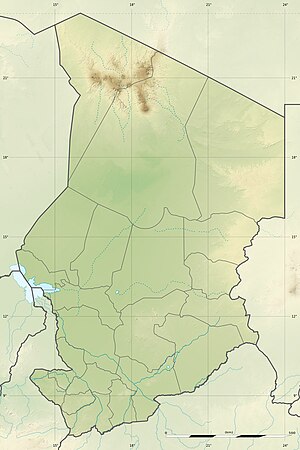Mega Chad
| Mega Chad | ||
|---|---|---|

|
||
| Maximum extent of the mega-Chad in the Holocene with the Shari from the south and the outflow over the Benue in the southwest | ||
| Geographical location | Chad | |
| Tributaries | Komadugu Yobe , Shari and Wadis | |
| Drain | Mayo Kebbi | |
| Data | ||
| Coordinates | 17 ° N , 18 ° E | |
|
|
||
| surface | 360,000 km² | |
|
particularities |
Former lake |
|
As mega Chad (also paleo-Chad ) refers to a prehistoric lake in the Chad Basin in Central Africa .
Lakes of the green Sahara time
Mega Chad was the largest of four great lakes that formed in the wetter era of Nigéro-Tchadia (10,000 to 2,000 BC; Neolithic subpluvial ) in the central Sahel . The other three were the Nubian Paleo Lake (approx. 1,000 km²), Darfur Mega Sea (approx. 30,000 km²) and the Mega Fezzan (approx. 150,000 km²).
Climate history
Scientists believe that the lake was filled at least twice in the history of the earth. About 55,000 years ago it is said to have had an extension of 1.95 million km², which would be about five times that of the Caspian Sea , which is now the world's largest lake. Then it dried up completely in the arid geological ages in Africa; This drying out was caused by the glaciation of the northern hemisphere. During this time, the dune advances up to today's 800 mm Isohyete line could be detected. These arid climatic conditions were to persist until 12,000 years ago, the climatic conditions changed to a monsoon climate and the humid age of the green Sahara began, so that the lake could arise again. Mega Chad had a fluctuating water cover. 11,500 years ago it reached a water depth of 15 meters, after which it reduced its size to the present day Lake Chad . 9,000 years ago it reached a depth of 38 meters. Mega Chad reached its greatest extent in the Holocene around 6000 years ago. At that time it covered an area of around 360,000 km², which corresponds to an average water depth of 65 meters. As part of the SRTM mission , the original shoreline could be detected at around 325 m , which corresponds to a maximum depth of around 170 m. Its lowest point was in today's Bodélé Depression .
expansion
At the time of its greatest expansion, the lake stretched from the Tibesti to the Ennedi massif in the north and in the south to what is now Cameroon and Nigeria . It covered around a third of today's Chad . Its main tributaries were the Shari , Logone , Komadugu Yobe , El Beid , Yedseram , Ngadda and the now largely dry Enneris ( Wadi ), which supplied the lake with water from the Tibesti and Ennedi.
Shrinkage process
Regional climate changes reduced the intensity of the West African monsoons . This led to a decrease in the water released into the lake and the water surface began to decrease steadily since the late Mesolithic (approx. 4000 BC). About 4000 years ago were from the former "mega-lake" only three residues left: Lake Chad , Lake Fitri and Bodélé lake . While Lake Chad and Fitri still exist today, Lake Bodélé has now dried up.
Geological clues
The lake left quite clearly visible traces in the landscape, such as on the Angamma cliff, at the valley exit of the Dilia de Lagané in Niger , the Bama Beach Ridge in the state of Borno in Nigeria . The earlier runoff can also be seen very well on satellite images. It still represents a connection between the Shari and the Niger system. During high tide near Bongor, the Logone feeds the Toupouri lowlands , which branch off to the southwest, with swamps that drain partly into the Benue and partly into Lake Chad. The Fianga lake , which is located in the former drain, experiences an average height fluctuation of up to two meters over the course of the year.
Individual evidence
- ↑ United Nations Environment Program (UNEP): Analyzing Environmental Trends Using Satellite Data: Selected Cases ( Memento of July 24, 2009 in the Internet Archive ), page 23 of the PDF file 5.29 MB
- ↑ History of Lake Chad Basin on the website of the Lake Chad Basin Commission (English)
- ↑ Palaeogeography, Palaeoclimatology, Palaeoecology, Vol. 239, No. 1-2. (12 September 2006), pp. 16-27.
- ↑ http://www.geog.ox.ac.uk/research/climate/projects/bodex/bodele_shorelines.pdf Lake shoreline in the sahara
- ↑ LAKE CHAD ( memento of March 24, 2014 in the Internet Archive ) on the NASA website (English)
- ↑ Lake Chad . Retrieved October 17, 2016.
- ↑ Frédéric Bouchette, Mathieu Schuster, Jean-François Ghienne, Cléa Denamiel, Claude Roquin, Abderamane Moussa, Patrick Marsaleix, Philippe Duringer: Hydrodynamics in Holocene Lake Mega-Chad (PDF document) (English)
- ↑ Natural spatial description of Borno on Onlinenigeria.com
source
Marc J. Leblanc, Christian Leduc, Frank Stagnitti, Peter J. van Oevelen, Chris Jones, Linus A. Mofor, Moumtaz Razack, Guillaume Favreau: Evidence for Megalake Chad, north-central Africa, during the late Quaternary from satellite data (2 , 6 MB, PDF file)

